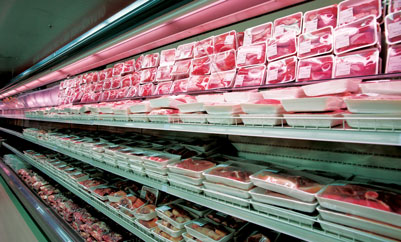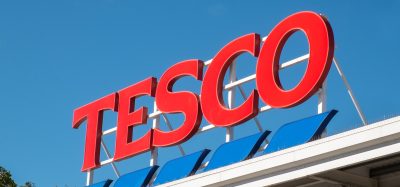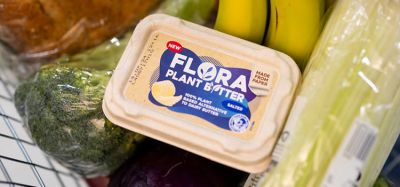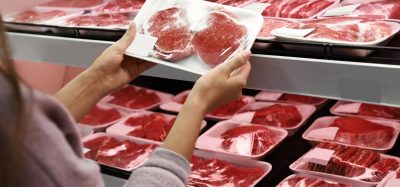New research gives further insights on O2-ingress in food packaging
- Like
- Digg
- Del
- Tumblr
- VKontakte
- Buffer
- Love This
- Odnoklassniki
- Meneame
- Blogger
- Amazon
- Yahoo Mail
- Gmail
- AOL
- Newsvine
- HackerNews
- Evernote
- MySpace
- Mail.ru
- Viadeo
- Line
- Comments
- Yummly
- SMS
- Viber
- Telegram
- Subscribe
- Skype
- Facebook Messenger
- Kakao
- LiveJournal
- Yammer
- Edgar
- Fintel
- Mix
- Instapaper
- Copy Link
Posted: 5 March 2014 | Peter Ragaert & An Vermeulen, Pack4Food and Mieke Buntinx & Roos Peeters, Research Group Packaging Technology & VerpakkingsCentrum, University Hasselt | No comments yet
Diversity in food packaging has become increasingly important in the last few decades due to different trends such as globalisation and convenience. This has resulted in an increased need for certain barrier properties in order to guarantee the desired shelf-life of the packaged food product. In the case of gas barrier properties, many food products need to be protected from oxygen, on the one hand making this parameter very important in evaluating new materials (e.g. bioplastics) for food packaging applications and on the other hand, there is an increased attention for investigating the influence of different processing techniques on the barrier properties of packaging materials.


A frequently used process in the food packaging industry is thermoforming. During thermoforming, an (inline) extruded sheet is heated to its softening temperature and subsequently deformed through application of mechanical stretching and/or pressure into a tray. This process directly impacts several properties of the sheet. One of these properties, especially in the case of food packaging under modified atmosphere (MAP – Modified Atmosphere Packaging), is the oxygen permeability. As a result of the increased surface area and thinning of the sheet, the OTR (Oxygen Transmission Rate) of the tray will be increased. However, various studies have shown that OTR values of the virgin material cannot easily be extrapolated to thermoformed packaging1-3. One of the reasons might be a poor control of the material thickness distribution in the walls, the corners and/or the bottom, which is a major drawback of thermoforming. On the other hand, the effect of physical thinning on the OTR can sometimes be counteracted by reorientation, closer chain packaging and restriction of chain mobility of amorphous polymer chains during deep drawing or stretching of the material. Reorientation and crystallisation is known to be related to altered sorption and diffusion of oxygen in polymer materials, and might cause a decrease of the OTR4.
Recently, the research groups Packaging Technology & VerpakkingsCentrum and Applied Analytical Chemistry of the University of Hasselt have conducted the Flanders’ FOOD MaProDe_Ox project in collaboration with companies from the Belgian food and packaging industry. The aim was to evaluate and quantify the impact of the thermoforming process on the OTR of several selected commercial packaging materials.
In this project, commercial sheet materials of monolayer polypropylene (PP); PP/ethylene-vinyl alcohol co-polymer/PP (PP/EVOH/PP); polystyrene/EVOH/polyethylene (PS/EVOH/PE); amorphous polyethylene terephtalate/PE (APET/PE); and APET/PE/EVOH/PE were thermoformed into three trays with the same top dimension of 190×132 millimetres and variable depths of 25 and 50 millimetres (radius one millimetre), and a variable radius of five millimetres for the corners of the 50 millimetre tray (Figure 1). The thickness of the sheets ranged between 350 and 400 µm. The EVOH content in the three multilayers was determined to be on average three per cent (the EVOH type used contained 32 mol% ethylene). The thickness distribution after thermoforming into three different trays was measured in detail and visualised showing the regions that were most affected by the deep drawn process for all test materials. Figure 2 shows an example of the 50 millimetre PP tray.
The oxygen transmission rate (OTR) of the sheets and the trays was measured using a Mocon Ox-Tran 2/21 in accordance with ASTM F-1927 and ASTM F-1307 respectively. The OTR of the trays increased with the drawing depth (Table 1). Increasing the radius of the corners in the 50 millimetres tray showed a beneficial effect on the OTR of PP and APET/PE. This study also confirms the excellent oxygen barrier properties of EVOH. The results show that around three per cent EVOH in the different multilayer materials is sufficient for deep drawing to depths of 25 and 50 millimetres. The OTR of the PP/EVOH/PP, APET/PE/EVOH/PE and PS/EVOH/PE sheets were in the same range (0.9-3.2 cc/m2.day.atm). The OTR of a 25 millimetre and 50 millimetre PP tray can be improved with a factor of 96 and 73 by the presence of an EVOH layer (around three per cent) respectively. The OTR of the 25 millimetre and 50 millimetre APET/PE/EVOH/PE trays was six and eight times better than the respective trays without an EVOH layer (Table 1).
More detailed results of this study indicate that the calculated OTR based on a homogenous material distribution, can be used as a rough approximation of the real OTR. However, detailed analysis of unequal thinning, orientation and crystallisation remains necessary to explain the deviation of the measured OTR as compared to the predicted one. Certainly in the case of monolayer PP, there is potential for improvement of the OTR as compared to the predicted value, due to reorientation of PP polymers during deep drawing.
The significance of the OTR values obtained in this study requires a translation in terms of the oxygen level in the package that will finally determine the shelf-life of the product in a modified atmosphere packaging. The O2-concentration in the packaging is thereby determined by (i) the residual O2 after packaging which is dependent on the filling-system and (ii) the O2 ingress during the shelf-life (OTR). On technical sheets the OTRs are often mentioned at 20-25°C while a lot of packed food products are stored in the cold chain. Therefore it is difficult to estimate the permeability of the packaging configuration under realistic storage conditions. To fill these gaps the software PredOxyPack® (www.predoxypack.com) has been developed in collaboration with Food2Know based on previous results of a Flanders’ FOOD project. The validation of this model was performed for monolayer and multilayer films and for the combination of bottles and caps, taking into account different temperatures. This validation is thoroughly discussed in Van Bree et al5.
PredOxyPack® allows the user to predict the oxygen ingress for different packaging configuration, materials and time-temperature profiles. In this way, realistic estimations can be made for the circumstances to which the food is exposed during its preservation including cold chain conditions. For the development of PredOxyPack®, a lot of attention is paid to the user-friendliness by among others (i) the incorporation of predefined packaging configuration for which the exchange surfaces and volumes are automatically calculated, (ii) the automatic unit conversions and (iii) a build-in permeability database of different packaging materials with minimum, maximum and default values of OTRs. Besides, users can also choose a custom packaging (e.g. pouch).
Once the user has chosen the packaging configuration, the composition of the packaging material can be inserted for each packaging component separately. The software easily permits inserting or deleting an extra layer. Next to the polymer type, the user has to indicate the OTR, test thickness and test temperature of the polymer. These data can be either filled in by the user based on technical sheets or automatically appear in the software based on a build-in database with default values for each polymer type. Finally the user has to fill in the actual layer thickness of the polymer in the multilayer. Based on this information, the residual oxygen level after filling and the time temperature profile to which the packed product is exposed during filling, transport and storage, the oxygen evolution in the package can be calculated.
The output screen of the software (Figures 3 and 4) represents a graphical output of the simulations (% or ppm O2 in the headspace as a function of time) together with the followed temperature profile. Next to this graph, a table with the summary of the input values is mentioned. This is important when a user wants to reopen previous performed simulations.
PredOxyPack® is used by among others food business operators (FBO), converters, packaging designers. It can help FBO to make the translation from the oxygen permeability which is mentioned on a technical sheet towards their specific packaged product during the reasonable foreseen conditions of storage e.g. within the cold chain. PredOxyPack® can give the FBO also a quick outcome on the comparison of different materials (based on the technical sheets) provided by one or different suppliers for the realistic conditions of the own packed product. With the software tool, the FBO can quickly compare new, innovative packaging materials and make sure that the required oxygen barrier can be achieved. Because of the various options regarding material choices, packaging design, time and temperature combinations, it is possible to explore in a first phase of the development a wide range of packaging options through the software tool without additional costs of testing all the materials. Based on these outcomes, the most promising concept could be analysed in a second phase with oxygen permeability measurements.
Regarding new upcoming materials, the build-in permeability database of PredOxyPack® will be updated regularly. Recently, an IWT-funded research project at Ghent University in collaboration with different research institutes (University College Ghent, Verpakkingscentrum, Belgian Packaging Institute and the technology centre of Flanders’ Plastic Vision) and 22 companies has been performed on the applicability of bioplastics for food packaging, including modified atmosphere packaging (MAP). Different packaging materials from renewable biobased resources were investigated for different properties such as O2– and H2O-permeability (Table 2), mechanical properties and seal properties6. Table 2 shows a high diversity in properties between the investigated materials, indicating that different types of food products can be packed, including those products that require a good O2– and/or H2O barrier. Furthermore, the obtained data in Table 2 are in the same range of different conventional food packaging materials such as OPP, PET/PE, OPA/PE, from a technical point of view making the investigated bioplastics valuable alternatives to those conventional materials.
The different materials have been subsequently tested in elaborated storage experiments with short (e.g. fresh red meat), middle-long (e.g. sliced meat products, grated cheese) and long shelf life food product (e.g. rice cakes). Tests with MAP-packaging of short and middle-long shelf-life food products showed amongst others that the barrier properties of different bioplastics were sufficient in order to maintain the desired gas mixture during the complete shelf-life period inside the packaging. This shows that MAP-applications by using bioplastics are possible. Therefore, these type of materials could also be considered as packaging materials for MAP-applications. It should be mentioned that the future use of bioplastics will depend, next to the technical performance, on the price evolution of these materials as well as transparent waste management options.
Research described in this publication was supported by grants from:
- Flanders’ Food, Belgium. MaProDe_Ox project: Impact of Material, Process and Design on the Oxygen Permeability of Thermoformed Packaging
- IWT (Institute for the Promotion of Innovation by Science and Technology in Flanders, Belgium) and 22 companies. IWT-CO 095062 Application of bioplastics for food packaging
- IOF10/StarTT/025. Development and commercialisation of a software package to predict the O2 ingress in packages for food products
References
- Crippa, A., Sydenstricker, T. H. D., Amico, S. C. (2008). Evaluation of Multilayer Thermoformed Films for Food Packaging. Polymer-Plastics Technology and Engineering, 47 (10), 991-995
- Pettersen M.K., Gällstedt M., Eie T. (2004a). Oxygen barrier properties of thermoformed trays manufactured with different drawing methods and drawing depths. Packaging Technology and Science, 17 (1), 43-52
- Pettersen M.D., Nilsson A., Espedal A., Kohler A. (2004b). Prediction of oxygen transmission rate for thermoformed trays. Packaging Technology and Science, 17(6), 321-332
- Robertson, G.L., Orientation. In Food Packaging: Principles and Practice, 3th edition. Robertson, G.L. Food Packaging Environment, Hope Island, Australia, CRC press, 2012, 152-155.
- Van Bree, I., De Meulenaer, B., Samapundo, S. Vermeulen, A., Ragaert, P., Maes, K.C., De Baets, B., Devlieghere, F. (2010). Innovative Food Science & Emerging Technologies, 11 (3), 511-519
- Peelman, N., Ragaert, P., De Meulenaer, B., Adons, D., Peeters, R., Cardon, L., Van Impe, F., Devlieghere, F. (2013). Review: Application of bioplastics for food packaging. DOI: 10.1016/j.tifs.2013.06.003







